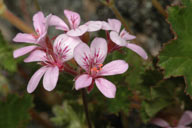In Flower This Week
A news sheet prepared by a Gardens' volunteer.
Numbers before each plant refer to temporary IFTW labels in the gardens.
Numbers in square brackets [ ] refer to garden bed Sections. Plants in flower are in bold type.
View past issues of 'In Flower This Week'.
26 November 2014
Pelargonium rodneyanum click for larger image |
A walk along the Main Path this time of the year is a rewarding experience. Flowers are plentiful from the moment you leave the Visitor Information Centre (VIC).
- On the left as you leave the VIC is a large specimen of Pandorea jasminoides [Section 212] covered in pink flowers and attractive mid-green foliage. This woody vine, also known as Bower of Beauty, is native to New South Wales and Queensland.
- Actinotus helianthi ‘Starbright’ [Section 221], or Flannel Flower, is in a pot on the right as you leave the VIC. The white flowers with yellow/grey centres have a velvety texture, as does the divided grey-green foliage.
- Further along on the left in a pot is Anigozanthos ‘Bush Volcano’ [Section 210], a long-lasting kangaroo paw with red/orange flowers.
- Homoranthus prolixus [Section 210] is also on the left in a pot. There is an interesting contrast between the layers of acid yellow flowers on blue-green foliage. This plant is restricted to an area of NSW near Inverell and its status in the wild is listed as Vulnerable.
- Low on the right is the groundcover Pelargonium rodneyanum [Section 174], or Magenta Storksbill, with small bright pink/purple flowers on green lobed ‘geranium’ leaves. It occurs naturally in fragmented populations in New South Wales, South Australia and Victoria.
- Detour across the lawn from the café to see the outstanding small tree Melaleuca linariifolia ‘Seafoam’ [Section 243]. This paperbark has many frothy white flowers and green needle foliage.
- On the left in the small garden is Grevillea sericea [Section 244], with white spider flowers on an open airy bush. The more common form of this plant has pink flowers. It is endemic to NSW.
- On the left in the Ellis Rowan Garden is Callistemon ‘Little John’ [Section 131], a dwarf form of Callistemon viminalis. This plant shows a stunning contrast between deep red bottlebrush flower spikes and green/blue foliage.
- Continue on the Main Path up the hill and look down to your left to see Baeckea astarteoides [Section 10], a small, delicate weeping bush with tiny pink flowers.
- Further on your left is Leptospermum ‘Aphrodite’ [Section 10], with pink and green ‘tea-tree’ flowers on a large open bush with small light green foliage. This plant was developed locally by Bywong plant breeder Peter Ollerenshaw. It arose among a batch of seedlings of Leptospermum spectabile.
- On your left overhanging the path is a Callistemon species [Section 10], with pink flower spikes on a small weeping tree.
- On the right is a small tree covered in white flowers with green centres. This is Leptospermum polygalifolium subsp. montanum [Section 9]. It is commonly known as Mountain Tea Tree or Tantoon.
- Further on your right is another large shrub, Kunzea ambigua [Section 9], covered in fluffy white blooms with a heavy honey scent. These flowers are much beloved by bees and other insects. It grows naturally on the coastal strip of eastern Australia (in New South Wales, Victoria and Tasmania).
- Again on your right is Grevillea insignis subsp. insignis [Section 9], an open, rather straggly bush with blue-green prickly holly-like leaves. The large pinkish flowers have dark red styles. It is native to south-west Western Australia.
- The groundcover to your right is Persoonia chamaepitys [Section 27], or Creeping Geebung, with orange/gold flowers and light green foliage.
Rosalind Walcott
![Director of National Parks [logo]](../../../../images/dnp_90px.gif)







